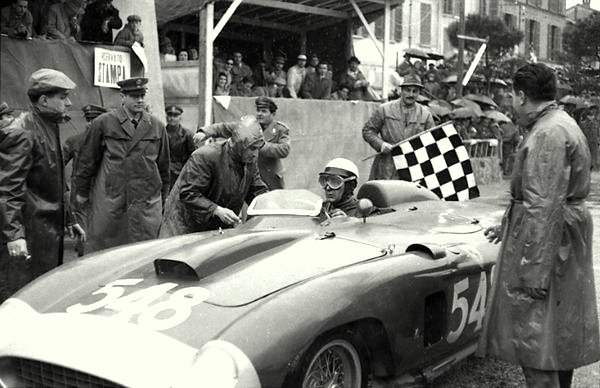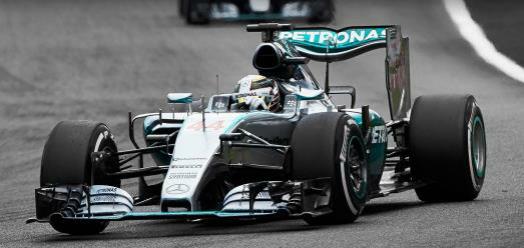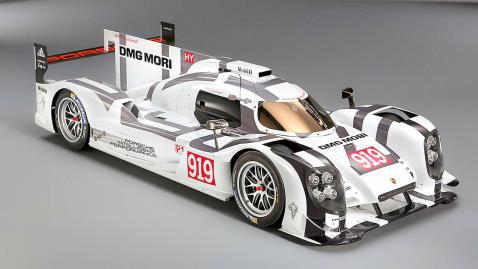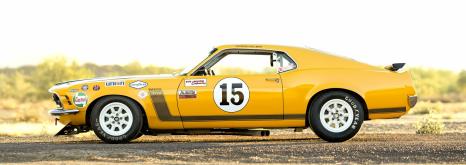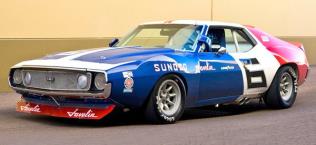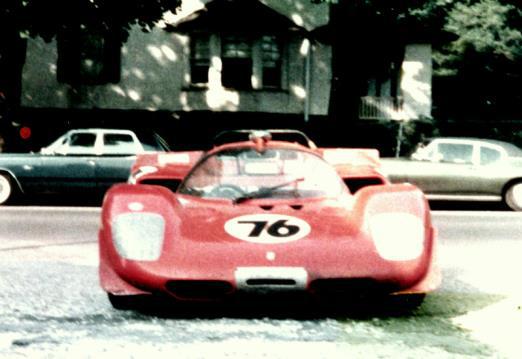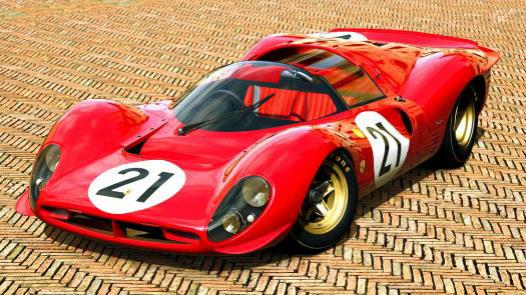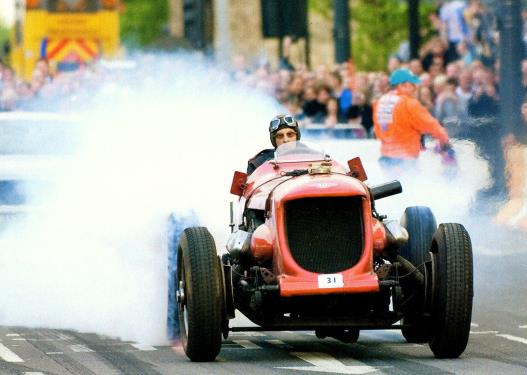Chapter 14
458
RETURNING TO THE EARLY NINETEEN SEVENTIES . . .
. . . a moment here to let you know that the format in the following chapters will, at times, step a bit wide of a chronological order. You have already had a taste of that with last story of Chapter 13.
As we went into 1970 it was a heady time. We had a number of tremendously good automobiles and we met some wonderful new people. Several would go on to become customers and friends.
And going into the seventies I pushed our newsletter content out considerably.
The negative spousal criticism in my household often grew to an untenable level in the evening. So, I purchased an expensive pair of Koss headphones, cranked in my music, poured the occasional scotch, and proceeded to write, and write, and write a bit more . . .
In looking through some of the Newsletters I came across a few stories that you may enjoy . . .
THE STATE OF AUTOMOBILE RACING, CIRCA 1970
In January of 1970 Brock Yates came to see us. I recounted that visit in our February, 1970 Newsletter. One thing led to another that afternoon, and we touched on the upcoming 1970 auto racing season.
459
It is astonishing to note the similarities of that discussion in 1970 with the state of today’s Formula 1 and FIA World Endurance Championship racing.
Here ’tis . . .
* * * * * * * * *
“BROCK YATES – The other day, Brock Yates of Car & Driver Magazine stopped in to visit with us. After following his writings and monthly column for so many years, it was a pleasure to simply have a quiet opportunity to sit and talk with him.
Brock recently purchased a Ferrari 250GT Lusso from us, and he’s genuinely fascinated with many of our great vintage Ferraris, our two pre-war Alfa Romeo’s, etc. His feelings are basically a coextension of my own, in that we have seen the end of a great era in these mighty sports racing machines of the fifties and sixties.
Sure, the Ferrari 512 is the ultimate competition Ferrari, but it’s so damned efficient, and has too many similarities to the Porsche 917’s, GT-40 Fords, etc.
In the Fifties when a big vicious 4.5 Ferrari was rolled to the ramp for the start of the Mille Miglia, the crowd knew the King of Beasts was about to erupt to life and rocket off into the dawn.
1956 MILLE MIGLIA, FANGIO
460
And by God, when one of those awful brutes did ignite, the earth shook and there were only two things on the minds of all Italians: Ferrari and the Pope, in that order. Try to imagine the whole thing with a 512.
(. . . remember now, it is 1970 . . .)
Would it really matter if a man were to sit by the starting ramp of the Mille Miglia by a switchboard and merely shoot the car off by remote control?
You can’t see the driver anyway and the damn things just don’t look like true racing cars any more. Have you seen some of these rear view photographs of a Group 7 Can Am car lately? Ludicrous!
John Bond of Road & Track recently wrote of the need to: “get some clothing on the backs of the current Formula 1 cars.” I agree completely.
I think the saddest aspect to the whole thing is the ever diminishing role of the driver in racing.
“The computer says to use 19” wheels in the rear, 3 wings and 2 spoilers in the front and one rudder and a wing in the back. Put the oil radiators in that open space where the driver used to be and we’ll run the car by radio this week.”
“The crowd will never know the difference.”
All of this is not to detract from the tremendous abilities of today’s drivers, or the great engineering and safety advances made with racing cars in the last decade.
I’m sure that some day in the future one of my sons may wax eloquent on the 512 as we do today with the great Alfas, Bugattis, and Ferraris, and he’ll probably state with authority that the 250 MPH average speeds at the coming Indianapolis 500 may kill any number of drivers this year for sure.
461
I‘ve included that short tale, written in 1970, because today we are steadily moving Formula 1 and World Manufacturers Endurance racing in a computer controlled and wildly overregulated direction. These are supposed to be the top tiers of motorsport. They are drowning in a sea of arbitrary overregulation.
The F1 cars of today are simply hideous to the eye, and their engine sound is strikingly reminiscent of an old fashioned “whoopee cushion.”
And all my whooping in 1970 about wings, computers, and the diminishing role of the drivers, is with us today in such abundance that the upper tiers of international automobile racing border on self destruction.
462
But, to an old fashioned guy that likes the Saturday night sprint car races on a dirt oval, I guess the crowning blow for me was struck by the notorious Automobile Club de l’Ouest this year at LeMans, the world’s most prized, endurance race.
With literally no notice, the ACO came up with a “Balance of Performance” index.
To give it to you in the simplest terms, if you were to show up at Le Mans in 2016, and you were foolish enough to demonstrate that you had a “kick-ass” race car, the “BOP” boys, right up until the starting gun, could come around and hand you an arbitrary number of pounds that you must add to chub-up your race car! In so doing, in their skewed vision, it would bring a “Balance of Performance” to achieve closer racing amongst you and your competitors!!
And yes, the ACO did “chub-up” the Ford GT’s, Ferrari, and wildly overshot the mark with the Porsche team, affecting that team heavily.
Mercedes Benz 1955
Mercedes Benz 2016
Handsome race car isn’t it ?
(. . . Sadly, I ain’t making any of that up . . .)
(So, let’s get away from all the heavy regulations and get back to a quick story about a great series where everyone just went racin’. . .! Again from the Newsletter . . .):
463
* * * * * * * * *
BRIDGEHAMPTON TRANS AM, June 21, 1970
Not the Trans-Am bunch. Extensive equipment everywhere surrounded by very serious looking personnel. No Gadfly’s in the pits with white Gucci’s, flowing silk shirts and scarves floating about. Just serious racing people.
Psyche rules the day. Everybody has transporters. Big rigs. Roger Penske wins hands down in this category with a support vehicle for almost everyone connected with the team.
The first sight that greeted me in the pits was a team Mustang completely draped in canvas with four feet sticking out from under the canvas.
There is very little exchange between the competing teams of AMC Javelin, Mustang, Camaro and the Plymouth Barracuda people.
Practice, though deadly serious, was uneventful with Swede Savage far and away the fastest, but I gathered no one figured him for the whole distance Sunday.
Sunday’s dawn revealed a typical Hampton’s June day with a stunning gray overcast, temperature in the 50’s and rain predicted momentarily.
We trundled out to the track and straight into the Circuit Club where it’s not allowed to rain.
There was a short practice before the race and Team Penske, the masters of preparation watched both Javelins cars go down the slot in the first twenty minutes as Peter Revson’s car blew up the engine on the back part of the course and Mark’s Transmission had something less than 4 gears reporting for work.
Mark came gliding into the pits and several team mechanics jumped on the job. To all observers, even with enormous speed and efficiency they weren’t going to make it.
464
* * * * * * * * *
Very close onto race time, one of the huge Penske transporters came slowly rumbling out of the pits and onto the track at a most sedate pace. It drifted slowly down the straight over the horizon and very carefully on around the track to the crippled Revson car which, of course, posed a serious danger, though parked well off the race track.
The crew aboard the truck wisely proceeded very slowly so as to not miss spotting the car. Once Revson’s Javelin was located, the truck was gradually brought to a safe halt.
Some team members got out of the truck, some didn’t. Those that did analyze the situation consulted the others still in the truck. Finally, they began to very carefully load the car. The Javelin was just about loaded when they decided they were loading the car the wrong way. The rear of the race car was to go in first, or is this the truck that takes it nose first? Better let the car back down on the track. So they let out yards and yards of cable, finally loading the car and securing it to a fare thee well.
The truck now further burdened by the weight of the Javelin, lumbered slowly back to the pit area. What seemed like hours later the giant truck slowly hove into view at the top of the straightaway, finally finding the pit entry.
Guess what had happened in the Penske pit while the slow motion theater was transpiring way out on the back part of the course?
Of course they have! Mark’s Javelin is repaired and being rolled to a waiting starting grid.
Wry smiles from all, including the fiercest rivals. A masterful move.
I’m a lousy race reporter, so I’ll be brief. Savage moved right out in front smartly with Jones and Donohue in pursuit. Indeed Savage was good for less than half the race, the Barracuda expired just prior to the halfway point.
Parnelli Jones and Mark Donohue was your race. Things were tight between them till they both pitted, which they did simultaneously, and Donohue jumped out 8 seconds before Jones did.
Mark sailed home the winner, literally, as the rains did arrive as scheduled.
465
Post race the “silly psyche” was heard. Penske: “We’ve got a good handle on these engines. Traco can now kick them up a bit further.”
The Mustang crew leaked a rumor that a good sized stone was found wedged under Parnelli’s accelerator, and anyway Ford had instructed their team not to win them all!!
The Trans Am series was really great racing and essentially simple as dirt!
The following is taken from the July 1970 Kirk F. White Newsletter recounting my first meeting with M.H. “Tiny” Gould:
MILFORD H. “TINY” GOULD, TRUCKSVILLE, PA. –
Upon meeting “Tiny” I was struck by his modest, quiet demeanor. I had heard a great deal about his tremendous knowledge and his collection of significant automobiles. He lived in a rural area above Wilkes Barre in northeastern Pennsylvania with the unlikely name of Trucksville!
Tiny Gould was neither tiny nor was he the other extreme. Tiny was a quiet unassuming man who commanded tremendous respect in the field of antique and classic cars. He was one of the genuine pioneers in the field.
He maintained his own restoration shop and although I’d seen several other facilities I’d never seen work like his. It was the finest anywhere.
Going through his inventory in Trucksville was an experience I doubt I will ever be able to duplicate. As you went through the door of his building the first thing staring back at you is J-101, the first Duesenberg J series Le Baron Dual Cowl Phaeton.
466
* * * * * * * * *
When he tells you he’s turned down $100,000 you’re not stunned; it seems entirely credible. This is followed by an SJ Duesenberg roadster, a huge Canadian McFarlan roadster, a Ruxton, and what was purported to be Tazio Nuvolari’s personal Monza Alfa Romeo, an S Mercedes, Tiny’s prize winning ’29 Packard Model 734 sport roadster. It just went on and on.
In an adjacent room there are 15 or 20 Motorcycles, all 4 cylinder models, virtually one of every make ever built.
Then a room of antique toys and another filled with standard gauge trains and yet another of guns and rifles.
Just when you think that’s all there could ever be, Tiny whisks you off to a huge Farm and in the sunset you approach this giant old Pennsylvania barn. He swings open the 30 foot high doors, and there staring back at you is this truly incredible collection of American racing cars. You turn back to take in the farm property and out over the lush meadow, there is a mare with her foal, the farm dog strolls along the lane. All is green, and a great evening sun is crimson in the valley.
You turn back and Lee Wallard’s Indianapolis 500 winning #99 is eyeing you, as is a Lockhart Indy Miller, and over there is the Victor Indianapolis 500 Buick and a good many more. You look at Tiny wondering if he might simply turn into Ted Horn and swiftly roar off into that great painted sunset.
Yeah, it really was very nearly too much to cope with.
* * * * * * * * *
467
The most beneficial aspect of that experience was that Tiny and I established a working association with Tiny Gould’s Antique and Classic Cars which would benefit both organizations. Both our areas of marketing were well established, ours being basically post war European, and Tiny being an undisputed authority on pre war American great cars.
We would work in the future in close collaboration each complimenting the other.
(And then in typical fashion I offered this grandiose epistle . . .)
“What it means is that between the two organizations you will be offered the greatest scope of authority and inventory in the history of the Thoroughbred automobile.”
(Good Lord, Kirk !. . .)
FERRARI 512 M SERIAL #1040
A bit of a preface:
So much has been written about this fantastic Ferrari and how it came to be. The late Michael Argetsinger’s superb book, “Mark Donohue”, is by far the most accurate account of the car from Donohue’s point of view, and the race accounting in Michael’s book is precise.
My bit of the story is from the standpoint of what it was like to actually be able to accomplish that amazing effort, in what was pretty much the very end of an era when you could just “do” things.
As this story unfolds you’ll soon see that what we actually put in place in 1970 and ’71 with that superb racing Ferrari couldn’t possibly be carried off today in the same fashion, or anything approaching it!
So, on to the story . . .
468
I always tried to steal a bit of quiet productive time very early Saturday mornings. Saturday mornings were totally quiet, no phones, no questions, no broken down transporters, no one with anything at all . . .
A Saturday morning in July of 1970, I had opened our 63rd Street garage office at about 6:00 in the morning.
But at 7AM that Saturday morning the front door opened abruptly. And in came another early riser, Roger Penske. Roger often drove past our place on the way to his Chevrolet dealership in west Philadelphia. His brother, David, and wife Trish were neighbors of mine and good friends. Roger and I knew each other socially, and I had been following his racing career since the late fifties.
Getting straight to the reason for his stopping, Roger merely said:
“Why don’t you round up a handful of your customer, investor, pals, buy a Ferrari 512, the necessary parts, a spare engine etc. We’ll take it over to Newtown Square and turn it into a real race car. We’ll enter it in the long distance races and run for the World Manufacturers Championship next year. Mark will drive it.”
I started to say something, but I have forgotten what it was. Didn’t matter anyway, Roger was on his way out again.
With his hand on the doorknob, leaving, he said:
469
“I’ve got to go; it would be a heck of deal. Think about it . . .”
After he left, I began to allow myself to dream the idea he had put out there. I had just enough knowledge of what Penske was doing in all forms of racing that I thought: “Just suppose you could take a really good solid Ferrari like the 512 series and put the car in the hands of the top automobile racing team in America.”
I didn’t get any more work done that morning. By ten in the morning I was calling the two key guys who would have to be players in the deal to get it underway.
We were in the midst of one of America’s worst tax structures as it pertained to the very wealthy. A corporate racing entity with Roger Penske’s organization was very appealing to both men. They in fact were very keen on the idea of Penske’s involvement with a Ferrari.
I was really getting amped up on the idea of pumping some good old fashioned American hot rod engineering into a “pretty good to start with” Ferrari 512. Yeah, it was the hot rodder coming out in me again. I knew just enough about the Penske Trans Am cars to know that there were a lot of hot rodders involved in moving and shaking that effort along very successfully.
I posted a three paragraph letter to Roger the following Thursday.
That’s all there was to it.
470
I wasn’t quite sure how to turn up a 512 that hadn’t already been run to death or crashed. The incredibly powerful and swift Group 5 cars had been in place since late 1968. They had all been raced, some crashed, and others abused or thrashed to death. We had better be in a position to turn over a pretty damn good example to Penske Racing as a starting point or we’d be waved away.
It wasn’t easy. Ferrari built only 25 examples of the 512. It took a while. In running the 25 cars down, a good many were quickly eliminated for any or all of the above reasons.
In the middle of the search, Roger called me at home on a Sunday to say maybe we should be looking for a Porsche 917. I told him it would explode the deal from my end, as I, and the friends involved, had no interest in the 917’s.
Shortly thereafter we found out that Ferrari 512S, serial #104o, was in the hands of Chris Cord and Steve Earle. Jim Adams was driving for them and the legendary hot rodder Doane Spencer was their crew chief. They were running the car in the Can Am series.
Yes, it could be for sale. They were coming to Mid-Ohio the weekend of August, 23 for the Can Am, and if they were to sell the car, it would be $32,000.
It looked like the car we should be buying. Roger said he’d send a couple of guys out to look the car over and watch it on the track at Mid-Ohio. Subject to a satisfactory inspection by Penske’s people and an “incident” free Can Am race, I would buy the car.
970 AMC Javelin-Mark Donohue
471
Penske’s guys green lighted the car. It arrived at our premises Monday, the 24th on a single car open trailer. The rig was driven by Doane Spencer, with a 14 year old Cris Vandagriff as his passenger!
The picture you see below is the car, literally as it rolled off the trailer, sitting in front of our office at 63rd Street. Sure didn’t look like 32 grand to me at that point!
Ferrari 512 #1040
Less than two hours later one of Penske Racing’s trucks appeared. The Ferrari disappeared into the gaping opening at the back of the enclosed transporter and it stole away for Newtown Square.
Not long afterward, Chuck Cantwell, the manager of Penske Racing, and one of the loveliest guys I’ve had the privilege of knowing, called and said Mark was taking the 512 to Reading Airport for some “lift and drag” tests. We were welcome to come along to watch if we liked.
When the 512 first got to Newtown Square, John Woodard noted that the car looked pretty used up, and beat.
472
Mark told John that they were going to rebuild the entire car, turn it into a coupe and race it at Daytona.
It would have been fun to see Woody’s immediate reaction to that statement at the time!
We went up to Reading and watched the lift and drag runs, which were largely accomplished without the bodywork on the Ferrari, making the car look even more bedraggled. The remarkable part of the day was the fact that Reading Airport was open during all this. Passenger fights were coming and going, not with great frequency, but a couple of times Mark was running at speed on a taxiway with a commercial aircraft running along on an adjacent runway!
Soon afterward, Mark took the car to Summit Point Raceway in Virginia to shake it down and get a true base line. When he arrived, he found the track leased for the day by a group of enthusiastic go kart racers. He waited patiently off to the side of the action. At the lunch hour he went out on the track and proceeded to break the track record by a substantial margin, did a few more laps, said thanks very much, and took the car back to Newtown Square.
The great adventure with this very special Ferrari #1040 is quite a saga. Over the course of the next several Chapters its story will continue . . .
In the meantime, going on at the same time: . . .
LIME ROCK RACE TRACK, JULY 1970
Kirk F. White Motorcars rented Lime Rock race track for the day. The cost was $400 dollars which included an elderly ambulance and the opening of a small food stall. We couldn’t call it a Vintage event; most of the participating cars weren’t old enough! Finally, the account is largely self deprecating, as I am far from being a qualified racing driver!
Picking up the story from our Newsletter . . .
473
* * * * * * * * *
“Very early that Saturday morning, a shrouded trailer slips into the deserted pit area at Lime Rock, Connecticut. Two competent men methodically unload a thoroughly savage Ferrari P3/4. It rests in the pit lane awaiting some further development. The men wait quietly.
Shortly, others begin to assemble. Obviously something of note is about to happen. Jim Haynes, who runs Lime Rock so efficiently, arrives; he is nervous.
More Ferraris appear, each of them different. A 330 2+ 2, a 250GT Lusso, a 250 short wheelbase Berlinetta, a California Spyder, a 365 GTB/4 Daytona (a what??) a ’65 275 GTB, and the 1961 Le Mans winning Testa Rossa! A bit later a wonderful Ferrari Mondial coupe and then several more Ferrari’s join the gathering.
Over a distant rise a cloud of dust is seen and a great black Rolls Royce James Young Phantom V limousine glides into the paddock. The rear door is opened sharply by a liveried chauffeur. The crowd gasps as someone alights resplendent in a chartreuse driving suit with lavender silk scarf flowing in the early morning breeze. The Cromwell helmet and split lens goggles complete the ensemble. The gathering is staggered. Glances toward the Phantom Rolls then back to the odd appearing man.
Yes, it must be! History will be made today! The Great “Smoke” has arrived to bring Lime Rock race track to its knees. The throng parts as the “unusual” piloto heads toward the mighty P3/4 Ferrari. The two helpers are apprehensive; the Ferrari P3/4, like all the other Ferrari racing cars was built to accommodate a 5’6”, 140 lb. Italian.
474
The Great “Smoke” is poised next to the beast in his Gucci alligator driving slippers. “Smoke” is neither small of stature and one would need to change the 140 pound number to something closer to 240 pounds!
With a hilarious attempt at dexterity “Smoke” slides, squeezes, stuffs, folds, and curses himself into the cockpit. Somewhere under his right leg is the shift lever which would be above the leg if he was actually in the seat and not over it!
No matter, the moment has come. The key is turned, the fuel pump switches thrown, and the engine rolled through only the starter motor 3 or 4 times to scavenge the oil, then over to full ignition and the mighty beast roars to life at a steady 1,100 RPM .
Most disappointing for the crowd. It’s not like in the movies; in real life the engines don’t roar and shriek when they are started. When they are cold anything over 1500 RPM can blow the oil filter into the next county.
At 1,100 RPM this baby sounds like it has about 7 cylinders reporting for work with run over rod bearings on 4 of those cylinders. The crowd looks momentarily worried, but then they remember that “The Great Smoke” is aboard and their fever pitch builds again.
After 3 or 4 minutes the oil temperature gauge comes off the peg and the goggles are pulled on. "Electricity" is your atmosphere as this combination of giants moves off onto the track. A Ferrari P3/4 steering has about one and a half turns lock to lock and unfortunately our “Smoke” sneezes at the end of the straight and misses both the turn and the escape road. Somehow gathering it back together, he roars down the short straight to the esses and all appears well. He tears into the first one beautifully but kind of misses the second. No matter.
On up the back straight, and he’s astonishing. For “Smoke” the power of this brute is impossible to comprehend, especially since he is bordering on a dead faint.
A quick check of the gauges and “Smoke” is within 5 feet of eating 7,000 cubic yards of clay in the tricky right hander at the end of the straight. There is no record of what happened on the rest of the circuit, but the “Great Smoke” was seen doing a lot of resting for the remainder of the day.
475
That friends, was one small segment of a wonderful day the Northeast Regional Members of the Ferrari Club of America spent in beautiful Lakeville, Connecticut. We had a great group of cars and people, perfect weather and two gracious hosts in Jim Haynes and Tony Koshland, the latter giving a delightful cocktail party that Saturday evening.
We all had such fun that Kirk F. White Motorcars, Inc. has rented the track again for Saturday, October 10th. Those of you wishing to attend should write me as quickly as possible as we are accepting only the first 20 car entries. Try and make it. The “Great Smoke” may even make a return appearance.
And, by George he did return:
LIME ROCK OCTOBER 10, 1970 – He did it; The “Great Smoke” returned, emulating MacArthur. He’s a giant hoax though.
This time everyone was faster on the track. Said he’s going to a driver’s school someday so he can live up to his costume which was further complimented this time by an ancient “Pudding Bowl” helmet and he had fashioned a very longish yellow silk scarf which was fully starched so it stretched back close to two feet from his neck as in the wind, don’t you know.
The Rolls Royce Club people who had come along for the day thought him quite odd.
The turnout was wonderful as we had 26 Ferraris and 7 Royce’s and Bentleys. The weather was superb and the New England foliage all around us was magnificent. We had such standout cars as Bob Dusek’s Ferrari 330P, Sid Stoldt’s 250 Monza, Frank Gallo’s beautiful 250 SWB Berlinetta, Art Summer’s 246 Dino, and Dr. James Wilkes “one off” 400 Super America fitted with a Short Wheelbase Berlinetta body. (This is a very special Ferrari and is reported to have been built for Ferrari himself who has shown a penchant for the big engined, lightweight road cars.)
(!!?? A good deal more on this car later . . .)
We all had a marvelous day and those of us going south went to Bill and Rene O’Donnell’s for a wonderful party where much bench racing was done. The “Smoke” was more than a bit of an annoyance though, with that damned scarf poking everyone in the ear, etc.
476
Following the party, Wilkes, White and Tegtmeier set out in their Ferraris for Philadelphia. It was an epic ride. I don’t remember any of the Saw Mill River Parkway. Once we reached the New Jersey Turnpike, I was able to drive again using both eyes . . .
(Now, who said a damned thing about alcohol?!)
We all, more or less, simultaneously decided it was not necessary to travel all the way to Bonneville to see if these beasts will actually turn 7,000 in top gear. Oh, it must have been a sight all right. Impossibly, we got away with it!
* * * * * * * *
IS THIS WHERE VINTAGE AUTO RACING MAY BE HEADED?
For more than a few of today’s vintage racing crowd, these, once simply fun, events have become hopelessly serious endeavors.
Some participants at today’s top events are arriving at the great circuits all over the globe with their multi-million dollar rigs laden with impossibly valuable vintage automotive racing baubles on board.
Already awaiting them at the circuit is a squadron of very well paid attendants, covering everything from the catering, hostesses, men to install the “keep away carpet”, tents, awnings, and, of course, the final barrier, handled by the “rope” people.
477
For those at the very top of the heap: the trainers, massage therapists, a chef and wait staff, and finally, the personal sushi chef for the owner’s wife’s special needs.
There are no mechanics. Instead, there are highly trained technicians, spread over several specialty fields: everything from air density engineers, to a gentleman who oversees the specific torque specifications of the tire valve stem caps.
The factory of origin, after going through a $120,000 authentication program, has subsequently prepared the car for this weekend’s event in their vintage racing department.
The engine innards are much the same as today’s FI engines. All components are the very best materials that money can buy. The engine’s original redline was suggested at 5,600 RPM. It will now bounce off the rev limiter at 8,400 RPM. All in, the car is 214 pounds lighter than that other marque example starting six rows behind you on the grid. Your tubular roll bar is filled with nitrous oxide to help you when that “stock” example, back there in the sixth row, starts looming in your thirty inch rearview mirror.
The four gentlemen seated over there with the laptops will attend to everything including vaporizing your racing vehicle at the end of the day. It will magically return to a factory “Classic Department” on the other side of the planet for rejuvenation.
478
Your attorney has filed all of your paperwork, along with the most recent addendums, and all of the latest safety certifications for, among other governing bodies, the FIA, FIVA, FIQ, FIG, and FI-FI-FO-FUM.
A second attorney is on hand with copies of the several briefs responding to the lawsuits filed by the three other owners who have identical cars with the same serial number as yours!
Finally, setting all of that aside, at some point you may be allowed into the cockpit of your vintage racer at a tightly appointed time, with your various layers of driving suit, Nomex underwear, approved driving shoes, slippers, socks, gloves, etc. It’s easy to get that part of the drill straight; it’s the same outfit you wore to last night’s cocktail party and dinner.
Finally you’ll don your “latest and greatest” full face, refrigerator white, “bobble head,” helmet and step into your tiny early fifties Cisitalia single seater . . .
. . .Can anyone else out there picture this: a completely gorgeous tiny Italian single seater, open wheeled racing car, or better yet, an early, nearly naked giant of an Edwardian racer with a “large” vintage driver at the wheel. (And, yes, they are almost always, “large;” It simply seems to come with the vast wealth . . .)
One’s eye is hopelessly drawn to the “bobble head doll” of a driver. These drivers bear much the same image as your top NFL star bobble-head dolls lined up across the rear window shelves of many large Midwestern American sedans!
479
Do any of those characters have any idea what may happen if they hit something really solid wearing one of those whoppers wrapped around their head, and no HANS device or head restraining measures of any sort?
Once in a great while you’ll still see a driver in a period cloth “helmet” or at least an open faced early Cromwell or early Bell type helmet, but you know they’re going to be black flagged one of these days soon for “safety” concerns . . .
"Oops, how the hell did he get in here. . . ? "
480
A FUNNY STORY, SUMMER 1970
We ferried a good many cars back and forth to New York and met some pretty interesting types who did the driving. During that time, a nice, well mannered, young man took a car to Stern Haskell in New York for us.
When he delivered the car in the late afternoon, Stern Haskell gave him a $30 check for the drive. He asked them to cash the check as he had only 38 cents left after ride. This they did gladly.
As this transaction was completed and he was again flush, I was told he gained a thoroughly patrician air, and as he was departing, announced to all and sundry that if there were any calls for him, he could be reached at the “21 Club” in Manhattan, where his $30 may have bought him a drink and a mediocre appetizer! And that, my friends, is a true story.
( . . . Sorry, sorry, it’s that fucking “soap box” of mine; just about the time you think I may have set it aside, out it comes . . .)
Well, that was great fun, getting all that out of my system!
And please, do not attempt to bring any rational safety arguments to my doorstep or visit the horrors of the litigious nature of this dreadful society we have assembled for ourselves today!
Okay, Okay let’s finish up with a couple of lighthearted tales from the seventies . . .
And speaking of $30, a final Newsletter Story:
* * * * * * * * *
481
“FOR, PROBABLY $30, I COULD DO A MOVIE OF THIS PLACE . . .
. . . but I expect no one would believe it”, said a customer of ours, almost to himself. He happened to be, at the time, the leading creative genius in the television advertising field in New York City.
“What are you talking about?” Someone said.
“Just take a look for yourself,” he said.
Every phone was ringing or busy with Phil giving his usual “Mr. White is on a long distance call, who’s calling please” into one phone while blowing glittering generalities into the other phone because he can’t remember who was on that line.
Mark Donohue’s waiting on the third line to ask a sensible question about the 512 which will probably have to be answered by our secretary, Mrs. Atkinson as she’s the only one left with a degree of sensibility.
Ed Casey is out in the middle of 63rd Street directing the world’s largest tractor trailer into the driveway to somehow load two Ferraris going to England, when the driver of the truck leaps out to yell at the guy in the street who’s been blowing his horn at him.
Just as the shouting is over, a second dual car rig arrives with a D-Jaguar and a Testa Rossa. There is no hope for him. He’s told to circle the block indefinitely.
About this time our Fred decides every car in the display area should be in a different spot.
The guy from the Public Relations outfit that we work with arrives and announces he’s here to get the Rolls to pick up Minnesota Fats at the airport and take him to the Mike Douglas Show. His chances are pretty good if he can get the Rolls straight up in the air and over all this mess.
482
Colin Crabbe of London, who has been our guest for the week, comes ambling through the door in a mammoth bear coat which he proudly announces he bought at the Hershey AACA meet, for $40. Colin was driving his newly acquired 1924 American La France Fire truck through the Flea Market when he spotted the coat!
Through this awful maze on 63rd Street, Major Coxson is seen skittering away in our ’21 Morris roadster shrieking “It’s my car, I love it, I’ll take it.”
Mike Tillson, after a long tedious tune on the Daytona, decides he’ll road test it. He opens the garage door, takes one look at the circus, fills the air with a blast of blue language and sails a 22 millimeter wrench across the shop.
Just as Eric ducks the wrench, the tractor trailer backs into building. More blue language.
Casey is now seen taking large swallows from a brown pint vessel.
Tegtmeier’s final scene is a fade through the bathroom window to avoid the advertising salesman that’s been after him for weeks.
Where am I? Why sitting in the D.O Hal dirt track car way back in the garage with my Cromwell helmet on writing this course.
Think it’s just all too incredible? Do you want to hear about the other half of the day?
We enjoy every minute of it and hope it goes on forever. Come and join us;
Tuesdays and Thursdays seem to be the best.
* * * * * * * * *
COMING NEXT:
CHAPTER 15, TUESDAY, AUGUST 22, 2016
FERRARI 330 P3/4
Trans Am Mustang


